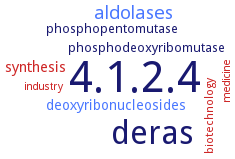4.1.2.4: deoxyribose-phosphate aldolase
This is an abbreviated version!
For detailed information about deoxyribose-phosphate aldolase, go to the full flat file.

Reaction
Synonyms
2-deoxy-D-ribose 5-phosphate aldolase, 2-deoxy-D-ribose-5-phosphate aldolase, 2-deoxyribose 5-phosphate aldolase, 2-Deoxyribose-5-phosphate aldolase, aldolase, deoxyribo, CGI-26, D-2-deoxyribose-5-phosphate aldolase, d5RP aldolase, DeoC, Deoxyriboaldolase, deoxyribose 5-phosphate aldolase, deoxyribose phosphate aldolase-like protein, Deoxyribose-5-phosphate aldolase, deoxyribose-phosphate aldolase, DERA, DPA, DR aldolase, Phosphodeoxyriboaldolase, TgDERA, TgDPA, Tk-DeoC, TK2104, TtDERA
ECTree
Advanced search results
General Stability
General Stability on EC 4.1.2.4 - deoxyribose-phosphate aldolase
Please wait a moment until all data is loaded. This message will disappear when all data is loaded.
not stable to freezing. Loses all activity when frozen and thawed
-
the enzyme directly immobilized through ionic exchange interactions on oxidized multiwalled carbon nanotubes is stable with a high tolerance to acetaldehyde, and maintains its activity for several days, being reused for five runs
the enzyme is highly resistant to a high concentration of acetaldehyde and retains about 35% of its initial activity after 5-h exposure to 300 mM acetaldehyde at 25°C
the enzyme retains more than 75% activity after exposure for 8 h to 300 mM acetaldehyde at 25°C.
the enzyme shows stability toward a high concentration of acetaldehyde (100 mM)
the immobilized enzyme is highly resistant to acetaldehyde. The enzyme immobilized on glutaraldehyde-(3-aminopropyl)triethoxysilane nano-magnet material retains 67.4% of its 2-deoxy-D-ribose-5-phosphate cleavage activity after incubation for 10 h in the presence of 300 mM acetaldehyde at 25°C. No activity is observed for the free enzyme after incubation for 3 h under the same conditions
-
the recombinant enzyme is stable in a buffer containing 2 M NaCl


 results (
results ( results (
results ( top
top





